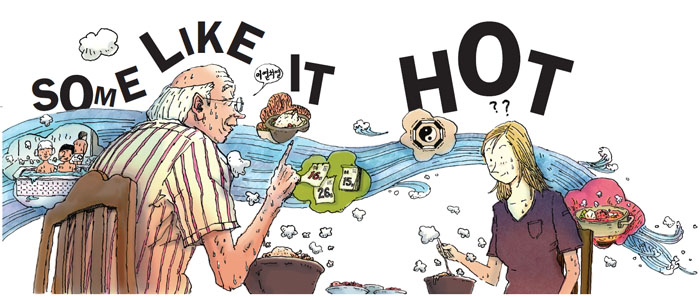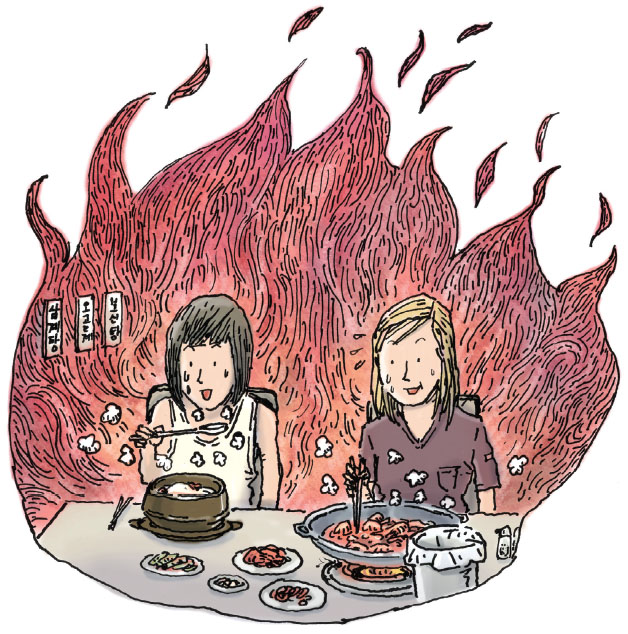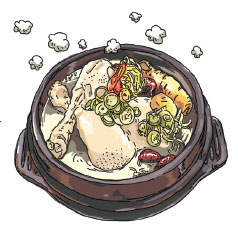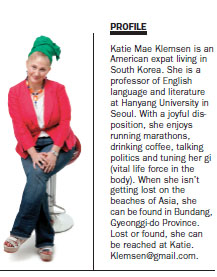View this article in another language
- 한국어
- English
- 日本語
- 中文
- العربية
- Español
- Français
- Deutsch
- Pусский
- Tiếng Việt
- Indonesian
Summer has arrived, and with it, thoughts of ice cream, ice-cold drinks and exulting under a spray of cool water. In Korea, however, locals embrace a more unorthodox approach: Food that makes you sweat away the hots. One American expat abandons her misgivings, heads off to a chicken broth restaurant and fights fire with fire.
All of the signs are here; long days, warm air and humid nights. Summer has, once again, found the Korean peninsula and as I sweat, live and struggle to breathe, I am searching for my own piece of siwonhada to ease the pains of summer. Siwonhada is a Korean term bearing similarity to the English expression “cool.” That is, in a literal and figurative sense, as well as an internal feeling of revitalization and refreshment. So, on my quest for summer coolness I promised myself I would try anything at least once, in hopes of banishing the heat and reaching a new level of “cool.”
Summer in Korea is a beautiful thing, save for the hot sun and humidity which, when left unchecked, can leave anyone lifeless and drained. When faced with moments like these I have options, three, to be exact: adapt, relocate or die. Despite my healthy love for the dramatic moments of life, death seems a bit much and, like most people, I hate moving house. I am then, in all of my sweaty glory, dedicated to adapting. Like any good expat, this is one more reason to get out there, dig in and go native.

When it comes to Korean people, some of the rumors are true. They love active, outdoor sports, they are one of the tallest groups of Asians and they thoroughly enjoy sweating over boiling hot stone bowls of spicy soup. Now, I would let the former slide if it were winter, but in this oppressive summer heat, I never really understood why an entire group of people would punish themselves with scalding soup on the hottest day of the year. So, like the curious foreigner I am, I asked. Lo and behold, I discovered a treasure-trove of cultural insight. As I listened to my 78-year-old surrogate grandfather, the pieces of the puzzle began to fall into place.
Grandpa Kim laid it all out for me — Koreans fight fire with fire. Initially, I didn’t understand if he was speaking to me about the recent tensions with the North Korea or something more culturally subtle. Thank heavens he is a patient man and had the wherewithal, as well as the English-language capacity, to verbally flowchart it for me. He explained to me that Korean people have a tradition of seeking hot and spicy foods to cool them down when the summer heat arrives. Now, I have heard of people drinking warm beverages to cool themselves, like taking in a hot mint tea in Morocco. But the idea of seeking to sweat it out, in an already balmy climate, was a lot like me: Foreign.
I learned a lot from Grandpa Kim and his aged-to-perfection wisdom. An ancient belief in the East dictates that the human body will only enjoy good health and harmony when the elements of fire, water, earth and metal are balanced. Apparently, my yin and yang was out of balance and my gi, or chi, was in need of a good tune-up. “So,” he told me, “you must release the heat.” Of course, during summer in Korea that is easier said than done. If I were left to my own devices, I might just lock myself in my house and blast the air conditioning. But because this is not a practical option, “fighting fire with fire,” or iyeolchiyeol in Korean, must be my succor.

Much to my dismay, the real summer heat lies ahead. The three hottest days in Korea are referred to as chobok, jungbok and malbok, and collectively as sambok. This year, they fall on July 19, July 29 and August 8. So, with my newfound cultural insight, I pulled my bootstraps up and hit the scalding pavement in search of Grandpa Kim’s cure-all, samgyetang.
Samgyetang is a traditional Korean chicken soup belonging to the group of foods referred to as “boyang foods.” These foods are said to replenish and nourish depleted yin and yang, gi and energy meridians. While there now seemed to be hope for my tattered gi, and while I was eager to find my siwonhada, I didn’t want to do it alone. Any new experience, heavy lifting or excessive sweating calls for good friends, and this was no exception. I called in a lifeline, phoned my dear friend Danae and committed to the experience.
After thoroughly researching nearby restaurants, I decided on one specializing in this revitalizing soup. On arriving, we were greeted by the owner of the establishment who gave us a broad, curious smile. Then, he handed me a pink Post-it bearing the number 17. Yes, there was a waiting line. Apparently, iyeolchiyeol is no joke. Danae and I, along with what seemed like an ever-growing number of Koreans, were all in search of summer coolness. By the time 17 was called, another 15 people were in line behind us.

We were ushered to a table, pre-set with all the necessities: Copious amounts of spicy kimchi, a dish of locally grown hot Korean green peppers, cucumber sticks, fiery hot pepper dip and what appeared to be a bone-bucket. Interestingly enough, we never placed an order. They knew what we had come for and, within minutes, two bubbling, boiling and steaming earthenware bowls were placed on our table. With a delight matched only by children on Christmas morning, I blew on the bowl to part the steam and catch my first glance of this tasty treat. The feast my eyes beheld was truly awesome.
Samgyetang is a whole, young chicken stuffed with glutinous rice, jujubes, dates, chestnuts, gingko nuts, garlic and young ginseng roots, served in a clear broth. It all made sense now. I finally understood this Korean insight. Grandpa Kim’s seemingly infallible wisdom had not led me astray. The restorative properties of all of the foods used in samgyetang had the potential to zap my muggy summer blues.
I rotated my chicken, investigating it, looking for the most logical place to begin. Still not knowing, I took to social cues from my fellow diners. The conclusion I arrived at was “just eat.” So I did. I alternated between tender chunks of chicken, perfectly prepared rice and savory broth, tipped my bowl and consumed every drop. Danae wasn’t far behind me and, between the two of us, we managed a dish of kimchi, two peppers each, diced peppery radish, and the whole lot of cucumbers. Needless to say, we filled the bone-bucket.
We cleaned each dish on the table and stared at each other in amazement. There we were, sweating brows and massive smiles, full and happy. Then we looked around. We were not alone. The whole restaurant was filled with diners, eating and sweating, sweating and eating. Audible murmurs of the word masisseo (delicious) filled the air, and there wasn’t an unhappy face to be seen. As the line at the restaurant hadn’t diminished — rather, it had grown considerably — we made our way to the cash register and happily paid for our first iyeolchiyeol experience.

As we left the protection of the covered awning, I felt a cold drop. Somehow, while searching for coolness, the humidity broke and for the first time in a long time, big, cold drops of rain began to fall. There was a new skip in my step. Whether it really was the soup, or some imagined benefits of it, I felt phenomenal. I couldn’t hold back and began to sing the first song that came to mind: I Feel Good. Through the corridor, down the hall and out the door, we sang the whole song. I’m sure, as Koreans walked past us smiling, they were thinking, “must be the samgyetang.”
The rain didn’t last, but it cooled the air. Finally, the Korean summer felt as light and fresh as I did. Danae and I didn’t go home right away. We loitered a while in the breeze of a new summer night, laughing and talking. We gushed about how satisfied and rejuvenated we felt, and the incredible energy now running through us. And in a small pause, between our laughs, I thought I heard a whisper. It was my gi. Do you know what it said? “Siwonhada.”
By Katie Klemsen | illustrations by Jo Seung-yeon | photograph by Kim Nam-heon
*The series of columns written by expats is about their experiences in Korea and has been made possible with the cooperation with Korea Magazine.
All of the signs are here; long days, warm air and humid nights. Summer has, once again, found the Korean peninsula and as I sweat, live and struggle to breathe, I am searching for my own piece of siwonhada to ease the pains of summer. Siwonhada is a Korean term bearing similarity to the English expression “cool.” That is, in a literal and figurative sense, as well as an internal feeling of revitalization and refreshment. So, on my quest for summer coolness I promised myself I would try anything at least once, in hopes of banishing the heat and reaching a new level of “cool.”
Summer in Korea is a beautiful thing, save for the hot sun and humidity which, when left unchecked, can leave anyone lifeless and drained. When faced with moments like these I have options, three, to be exact: adapt, relocate or die. Despite my healthy love for the dramatic moments of life, death seems a bit much and, like most people, I hate moving house. I am then, in all of my sweaty glory, dedicated to adapting. Like any good expat, this is one more reason to get out there, dig in and go native.

When it comes to Korean people, some of the rumors are true. They love active, outdoor sports, they are one of the tallest groups of Asians and they thoroughly enjoy sweating over boiling hot stone bowls of spicy soup. Now, I would let the former slide if it were winter, but in this oppressive summer heat, I never really understood why an entire group of people would punish themselves with scalding soup on the hottest day of the year. So, like the curious foreigner I am, I asked. Lo and behold, I discovered a treasure-trove of cultural insight. As I listened to my 78-year-old surrogate grandfather, the pieces of the puzzle began to fall into place.
Grandpa Kim laid it all out for me — Koreans fight fire with fire. Initially, I didn’t understand if he was speaking to me about the recent tensions with the North Korea or something more culturally subtle. Thank heavens he is a patient man and had the wherewithal, as well as the English-language capacity, to verbally flowchart it for me. He explained to me that Korean people have a tradition of seeking hot and spicy foods to cool them down when the summer heat arrives. Now, I have heard of people drinking warm beverages to cool themselves, like taking in a hot mint tea in Morocco. But the idea of seeking to sweat it out, in an already balmy climate, was a lot like me: Foreign.
I learned a lot from Grandpa Kim and his aged-to-perfection wisdom. An ancient belief in the East dictates that the human body will only enjoy good health and harmony when the elements of fire, water, earth and metal are balanced. Apparently, my yin and yang was out of balance and my gi, or chi, was in need of a good tune-up. “So,” he told me, “you must release the heat.” Of course, during summer in Korea that is easier said than done. If I were left to my own devices, I might just lock myself in my house and blast the air conditioning. But because this is not a practical option, “fighting fire with fire,” or iyeolchiyeol in Korean, must be my succor.

Much to my dismay, the real summer heat lies ahead. The three hottest days in Korea are referred to as chobok, jungbok and malbok, and collectively as sambok. This year, they fall on July 19, July 29 and August 8. So, with my newfound cultural insight, I pulled my bootstraps up and hit the scalding pavement in search of Grandpa Kim’s cure-all, samgyetang.
Samgyetang is a traditional Korean chicken soup belonging to the group of foods referred to as “boyang foods.” These foods are said to replenish and nourish depleted yin and yang, gi and energy meridians. While there now seemed to be hope for my tattered gi, and while I was eager to find my siwonhada, I didn’t want to do it alone. Any new experience, heavy lifting or excessive sweating calls for good friends, and this was no exception. I called in a lifeline, phoned my dear friend Danae and committed to the experience.
After thoroughly researching nearby restaurants, I decided on one specializing in this revitalizing soup. On arriving, we were greeted by the owner of the establishment who gave us a broad, curious smile. Then, he handed me a pink Post-it bearing the number 17. Yes, there was a waiting line. Apparently, iyeolchiyeol is no joke. Danae and I, along with what seemed like an ever-growing number of Koreans, were all in search of summer coolness. By the time 17 was called, another 15 people were in line behind us.

We were ushered to a table, pre-set with all the necessities: Copious amounts of spicy kimchi, a dish of locally grown hot Korean green peppers, cucumber sticks, fiery hot pepper dip and what appeared to be a bone-bucket. Interestingly enough, we never placed an order. They knew what we had come for and, within minutes, two bubbling, boiling and steaming earthenware bowls were placed on our table. With a delight matched only by children on Christmas morning, I blew on the bowl to part the steam and catch my first glance of this tasty treat. The feast my eyes beheld was truly awesome.
Samgyetang is a whole, young chicken stuffed with glutinous rice, jujubes, dates, chestnuts, gingko nuts, garlic and young ginseng roots, served in a clear broth. It all made sense now. I finally understood this Korean insight. Grandpa Kim’s seemingly infallible wisdom had not led me astray. The restorative properties of all of the foods used in samgyetang had the potential to zap my muggy summer blues.
I rotated my chicken, investigating it, looking for the most logical place to begin. Still not knowing, I took to social cues from my fellow diners. The conclusion I arrived at was “just eat.” So I did. I alternated between tender chunks of chicken, perfectly prepared rice and savory broth, tipped my bowl and consumed every drop. Danae wasn’t far behind me and, between the two of us, we managed a dish of kimchi, two peppers each, diced peppery radish, and the whole lot of cucumbers. Needless to say, we filled the bone-bucket.
We cleaned each dish on the table and stared at each other in amazement. There we were, sweating brows and massive smiles, full and happy. Then we looked around. We were not alone. The whole restaurant was filled with diners, eating and sweating, sweating and eating. Audible murmurs of the word masisseo (delicious) filled the air, and there wasn’t an unhappy face to be seen. As the line at the restaurant hadn’t diminished — rather, it had grown considerably — we made our way to the cash register and happily paid for our first iyeolchiyeol experience.

As we left the protection of the covered awning, I felt a cold drop. Somehow, while searching for coolness, the humidity broke and for the first time in a long time, big, cold drops of rain began to fall. There was a new skip in my step. Whether it really was the soup, or some imagined benefits of it, I felt phenomenal. I couldn’t hold back and began to sing the first song that came to mind: I Feel Good. Through the corridor, down the hall and out the door, we sang the whole song. I’m sure, as Koreans walked past us smiling, they were thinking, “must be the samgyetang.”
The rain didn’t last, but it cooled the air. Finally, the Korean summer felt as light and fresh as I did. Danae and I didn’t go home right away. We loitered a while in the breeze of a new summer night, laughing and talking. We gushed about how satisfied and rejuvenated we felt, and the incredible energy now running through us. And in a small pause, between our laughs, I thought I heard a whisper. It was my gi. Do you know what it said? “Siwonhada.”
By Katie Klemsen | illustrations by Jo Seung-yeon | photograph by Kim Nam-heon
*The series of columns written by expats is about their experiences in Korea and has been made possible with the cooperation with Korea Magazine.